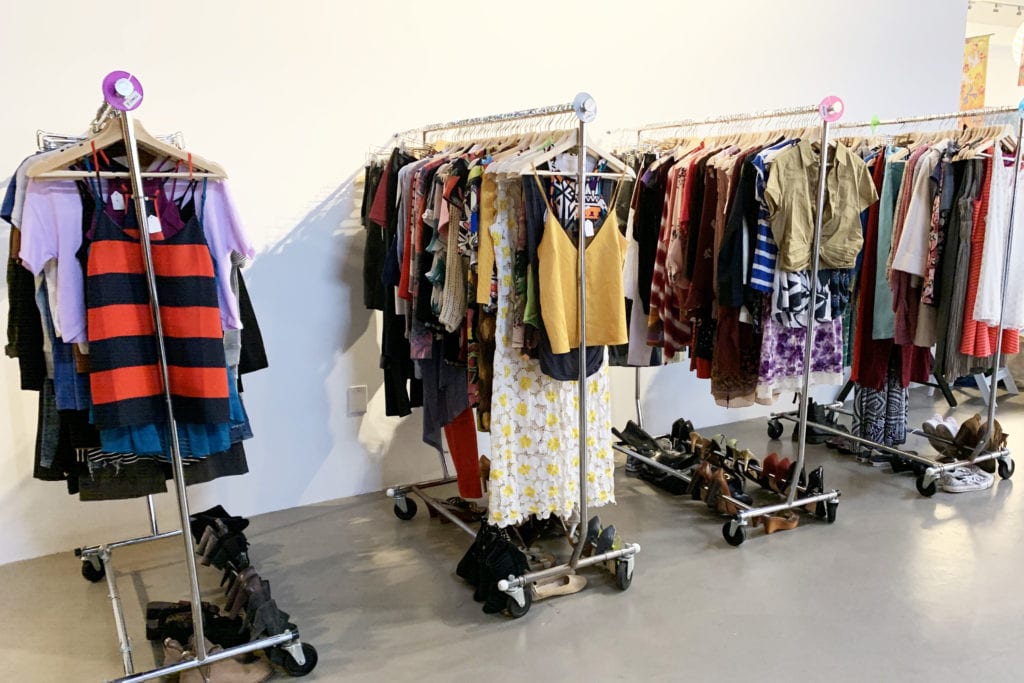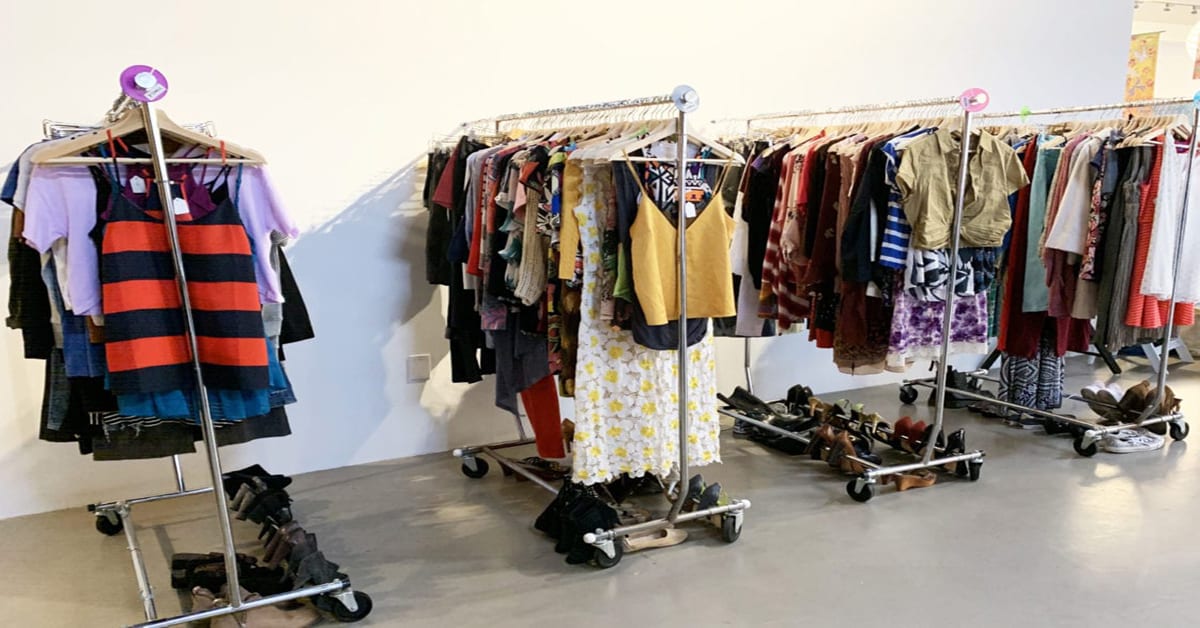It’s time for us to switch to a sustainable wardrobe.
Researchers from Manchester University, UK, published a report earlier this year in Nature Reviews Earth and the Environment, estimating that the fashion industry is responsible for 10% of global CO2 emissions, and 1.5 trillion liters of water annually.
However ethical we like to think we are, we all have that fast fashion $5 sale top that was far too cheap to be ethical or the acrylic jumper that sheds microplastics into the water supply every time we wash it. Removing plastics from your life and creating a sustainable wardrobe can feel like an insurmountable task.
Throwing it all out and starting again, while being a grand gesture, will only further contribute to the mountain of global textile waste already in existence (13 million tonnes annually). Instead, here are 10 ways you can work towards building a sustainable wardrobe.
How To Build A Sustainable Wardrobe
Choose your fabrics wisely
One of the easiest ways to ensure that you’re not contributing to environmental harm with your fashion choices is to consider fabrics. Here are a few quick pointers:
- Avoid fabrics that use microfibres. Synthetic fabrics like acrylic, polyester, and nylon are all made from oil, use harmful chemicals in production, are not biodegradable, and shed their fibers, polluting our water sources.
- Avoid conventional cotton. Even though it does biodegrade, cotton has a terrible environmental impact. It takes 20,000 gallons of water to make a single pair of jeans, and high levels of pesticides are needed to grow the crop.
- Choose linen. Linen is a great example of a fabric that is sustainable through the whole process, from planting, through harvesting, to production. Flax needs little water and no pesticides, and the parts of the plant not used for linen production are used elsewhere. Linen completely decomposes in just 2 weeks! Brands like Montaigne Paris source 100% Italian linen clothing, perfect for your sustainable wardrobe.
- Choose recycled fabrics. More and more brands are looking into working with recycled fabrics, particularly wool, cotton, and synthetic fabrics. This method obviously uses fewer resources to manufacture, results in less waste and can encourage more inventive design.
Mend your clothing

The art of shashiko, or mending, has made a comeback, especially in the western world in the last few years. It’s a beautiful way of mending your favorite clothing when they become tattered or torn and it doesn’t take a long time. You can find video tutorials for mending almost everything on Youtube, or why not join a local sewing circle?
Buy with intention
Being thoughtful about what you buy is key to creating a sustainable wardrobe. Why not begin each season by organizing your wardrobe? This way you can consider how the items you already own work together, think about creative ways to style your pieces and work out what you actually need to buy.
Shopping trans-seasonally, buying pieces that will work (with layering, or clever styling) all year round will make your wardrobe even more sustainable.
Shop ethically
When it comes to sustainability, we can’t just look at the environmental impact of what we wear. There are 3 pillars to consider if you want to shop ethically:
- Environmental: What resources and chemicals are used in production? Does the fabric break down easily?
- Economic: Does this piece of clothing represent value for money? How many wears will you get out of it?
- Social: Who made your clothes, where did they make them, and what conditions were they working under?
But how do you find these things out?
Research your brands
The phenomena of “Greenwashing”, or companies using PR spin to convince customers that they are looking after the environment, is as common in the fashion industry as elsewhere. It’s really easy for brands to jump on the eco-bandwagon if they think it will result in more sales. Here’s how you can get to the truth:
- Look for a brand’s impact report. This will outline the specific standards they abide by when it comes to the environment, and the people they work with.
- Look for accreditation, for example, GOTS certification, to show that a third party considers this company to be working ethically
- Choose smaller companies, who will be more involved in every stage of the production and manufacturing process, rather than outsourcing to a questionable factory in a country with questionable worker’s rights.
- Ask brands directly. Social media is a great place for this, as brands want to show that they are engaging with customers.
Buy second hand

Buying second-hand clothing – especially swapping clothes – is pretty high up there on the sustainability scale! No new impact on the environment, no more production costs or processes, and you’re helping to reduce textile waste. It can be a minefield, however, unless you pay attention to these steps:
- Try before you buy. If you’re shopping in person then you need to try things on. As you know, different brands have different size guides, and if you’re buying vintage then a size 12 is unlikely to be a modern size 12. If you’re buying online, then pay attention to the description, and ask the seller questions if you’re still not sure.
- Check fabric care labels. You can find out what the garment is made of here, and also how to look after it. Dry clean only? Not if you’re trying to build a sustainable wardrobe.
- Look for stains or holes. 2nd hand means cheaper, but you don’t want something that’s been worn and damaged (unless you’re particularly handy with a sewing machine). Some things are fixable, for example, an undone hem, but some are not, and you don’t want to buy it and find a burn mark on the back later.
- Check the price. With the rise in popularity of vintage clothing, some stores can hike prices up for pieces that aren’t worth it. As with new clothes, will you wear this piece enough for the price to be worth it? If not, then walk away.
Take care of your clothing
The impact of our wardrobes doesn’t stop once we’ve handed over the cash. How we care for our clothing makes a difference too. There are some easy do’s and don’ts when it comes to washing and drying our clothes.
- Do hang clothing after wearing. Helping your garments keep their shape means they’ll last longer, and you’ll wear them more. Keeping them crumpled on the bedroom floor makes it more likely that you’ll just throw them straight in the wash.
- Do reduce washing. The Energy Saving Trust estimates that washing accounts for 60-80% of a garment’s environmental impact. We’ve gotten used to washing clothes after every wear, but this isn’t usually necessary. Consider wearing something again unless it’s obviously smelly or dirty.
- Do use cold water. Washing at 30 degrees rather than 40 degrees reduces energy consumption by 40%. As long as your machine is full enough to ensure agitation (the clothes rubbing together during a cycle actually does much of the cleaning) then that’s hot enough to get most things clean.
- Do use a delicates bag. A delicates bag will help to increase the lifespan of your delicate clothing, as well as protecting other clothing in the wash from buttons, zips, or hooks.
- Don’t dry clean. Not only is dry cleaning terrible for the environment but it’s harsh on clothes. Skip dry cleaning by checking the label before you buy and avoiding dry clean only items.
- Don’t tumble dry. Tumble drying uses more energy than air drying, obviously, but it also breaks down the fibers of your clothes more quickly, meaning that they wear out faster and will need replacing sooner.
Learn to sew.

Learning to sew is a fantastic way to complete your sustainable wardrobe. There are two elements here, sewing your own clothes and upcycling used clothing.
By sewing your own clothing you are almost completely in control of the manufacturing process and are able to choose every element that is used in your clothing, from the fabric to the ideas. You could choose to use flax linen along with organic cotton thread and wood buttons to make a beautiful item that is completely unique and sustainable.
Upcycling used clothing is another great way to make clothing more sustainable. By prolonging the life of items instead of throwing them away you are reducing your impact on the environment and you’ve turned a loved, but unwearable piece, into something new and fresh that fits with your current lifestyle.
Buy quality, buy less.
Vivienne Westwood, the visionary British designer, famously said: “Buy less, choose well, make it last”. Buying cheap, while being lighter on our pocket at the time, can have a huge impact further down the line. Instead, consider buying clothes that will last.
When you’re looking at an item, look closely at hems and seams; how well do you think they will stand up to wear over the long term? Think about the quality of the material. Does it feel cheap and likely to rip or fray?
Pieces that are of higher quality tend to be lined, to have binding sewn over seams to prevent pulling or tearing, and to be made of more natural fabrics (such as linen, wool, or cotton).
Consider the afterlife.
Never throw clothes in the bin! There are many steps you can go through to make sure that, even if something no longer works for you, it still has a lot of life left in it.
- Sell on. As well as the obvious Ebay, there are countless 2nd hand online marketplaces, and this can be a lucrative way of passing on your unwanted pieces. Make sure you are realistic and detailed in your descriptions.
- Donate. Even if you no longer fit into your favorite jeans, someone else will, and they’ll be chuffed to find them at a reduced price!
- Recycle. Even if something can’t be worn in its current state, if it is clean and the fabric is still of good quality, then it can be recycled.
- Use as cleaning rags. The final stage in the reuse chain: a ripped T-Shirt can make a perfect cloth for cleaning your windows!
Your sustainable wardrobe awaits
Every blouse and pair of jeans that make it from your online basket to your door has an environmental cost. These 10 tiny steps will take you in the right direction, towards a more useful and more sustainable wardrobe, giving you peace of mind each time you stand in your bedroom trying to work out what to wear in the morning!
Guest Author:
Zoe Harvey lives with her family in Adelaide, Australia. She is passionate about sustainability and ethical consumption and is the Digital Marketing Manager for Etika Imports.




